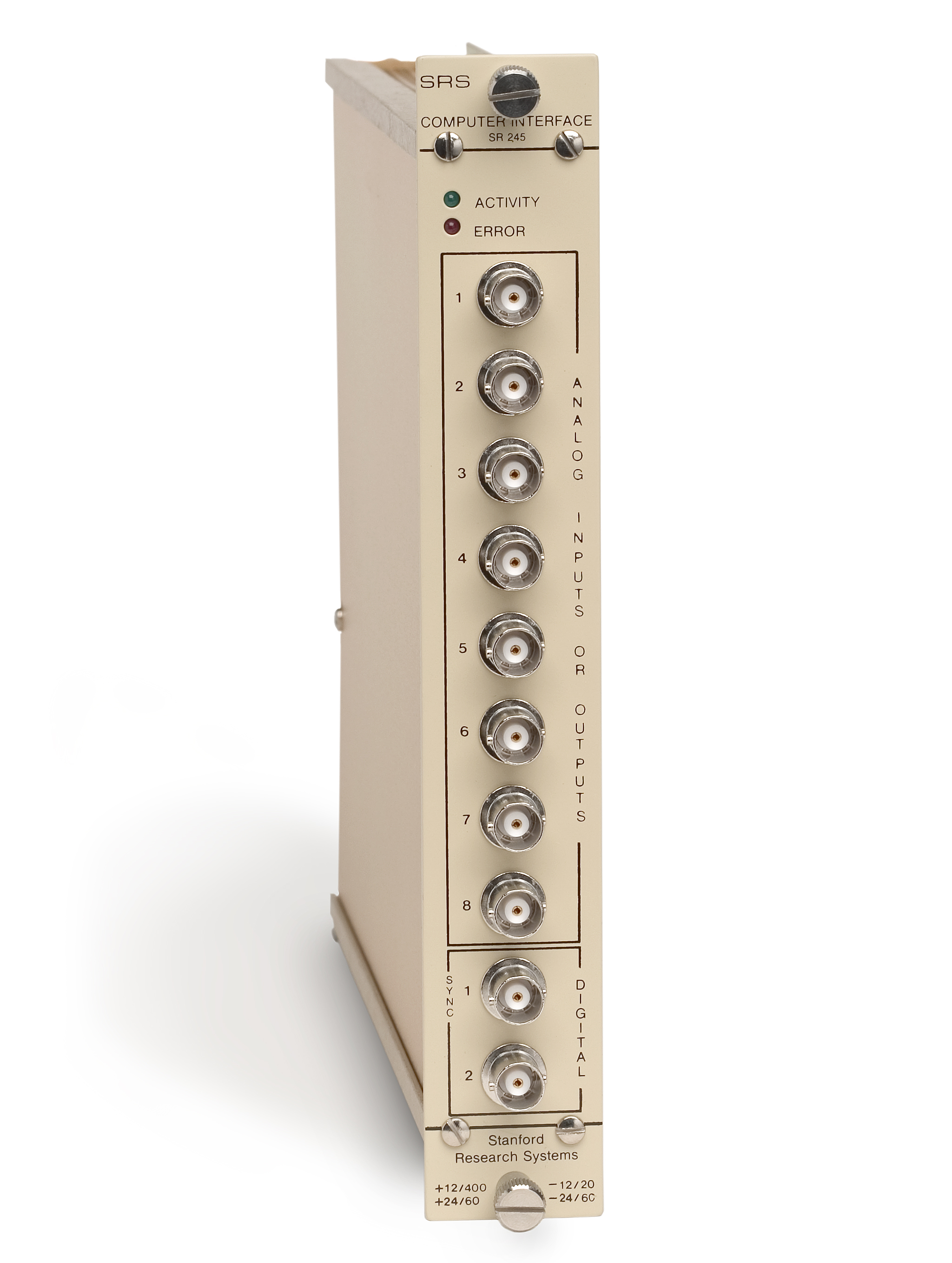
SR245 Computer Interface (GPIB & RS-232)



| The SR245 Computer Interface module is a powerful tool for data acquisition. It provides both an analog and a digital interface between your computer and your experiment. |

SR245 Computer Interface (GPIB & RS-232)


SR245 Computer Interface (GPIB & RS-232)

| ... click for SR245 Tech Support |
SR245
The SR245 Computer Interface module is a powerful tool for data acquisition. It provides both an analog and a digital interface between your computer and your experiment.
Analog I/O
The eight analog I/O channels can be designated through software as all inputs, all outputs, or as a combination of inputs and outputs. All channels have 13 bits of resolution over the ±10.24 VDC full-scale range, with 0.05 % accuracy.
Digital I/O
Two front-panel digital I/O bits are provided for use as counters or triggers and can be set or read by the computer. Additionally, an
RS-232 and GPIB interfaces
Both RS-232 and GPIB interfaces are standard features of the SR245. Simple commands make programming easy from a variety of high level languages—all that's necessary is the ability to send and receive ASCII strings. For example, sending "?5" instructs the module to measure the voltage on the 5th analog input BNC. Other commands allow you to record in the module's 3500 point buffer memory, ramp an analog output at a specified rate (for gate scanning), or read the contents of a digital counter.

SR245 Specifications |
|
Analog Ports |
|
| Configuration | Any number of the eight ports may be designated under program control as input ports, the rest default to output ports. |
| Inputs | 1 MΩ impedance, ±10.24 VDC range, protected to 40 VDC. |
| Outputs | <1 Ω impedance. Short circuit current limit is 20 mA. |
Digital Ports |
|
| Type | Two front-panel I/O TTL bits, one |
| Front-panel Inputs | Input impedances >100 kΩ. Minimum pulse width is 200 ns. Maximum count rate is 4 MHz. Logic one >3 VDC, logic zero <0.7 VDC. Inputs protected to ±10 VDC. |
| Front-panel outputs | Can drive 50 Ω loads to TTL levels |
General |
|
| Interfaces | IEEE-488 (GPIB) and RS-232 (110 baud to 19.2 kbaud) |
| Power | +24 V/60 mA, 24 V/60 mA, +12 V/20 mA, approx. 8 watts |
| Mechanical | Single-width standard NIM module |
| Warranty | One year parts and labor on defects in materials and workmanship |
Input/Output Commands |
|
| I<n> n=0 to 8 | Designates the first n analog ports as inputs, the remainder become outputs. |
| ?<n> n=1 to 8 | Returns the value of the designated analog port. |
| ?B<n> n=1,2 | Returns the value (0 or 1) of the designated digital port. |
| ?D | Returns the value of the 8-bit digital input port. |
| ?S | Returns the value of the status byte, and clears the status byte. |
| C | Configures B2 as an input and resets the B2 counter. |
| ?C | Returns number of pulses occurring at B2 since the previous ?C. |
| S<n>=<x> | Sets the analog port n (which must be designated as an output) to the value x |
| SB<n>=<m> | Designates digital bit n as output and sets its value |
| SB<n>=I | Designates the selected bit as an |
| SD=<n> | Sets the 8-bit digital output port to the value n |
| SM=<n> | Sets the GPIB SRQ mask to the value |
Trigger Commands |
|
| MS | Sets the synchronous mode. Responses to ? commands are returned after next trigger. |
| MA | Sets the asynchronous mode (default). Responses to ? commands are returned after command is received. |
| T<n> | Designates every nth pulse at B1 as a trigger |
| DT | Masks the trigger input so that no triggers are recognized |
| ET | Unmasks the trigger input |
| PB<n> | Outputs a 10 µs TTL pulse at digital port |
| P/<n> | Outputs a 10 µs TTL pulse at B2 each nth |
Scan Commands |
|
| SC<i>,<k>:<n> | Scans the list i..k of analog ports or digital port for n triggers. Total # of samples may not |
| ES | Ends the current scan immediately and resets the point sending counter. |
| N | Sends the next point of stored scan |
| ?N | Returns # of points scanned |
| A<n>,<i> | Adds n × 2.5 mV to the value of analog port 8 (must be positive) on every ith |
| SS<i>,<k>:<n> | Scans the list i..k of analog ports or digital port for n triggers. Data is sent in a 2 byte binary format while scan is in |
| X | Sends the data of a stored scan in 2 byte binary format. |
Miscellaneous Commands |
|
| MR | Master Reset. Returns the SR245 to its default values. |
| W<n> | Introduces a delay of (n × 400 µs) before sending each character over the |
| Z<i>,<k> | Changes the end-of-record characters sent by SR245 to those specified by the ASCII codes, i...k |
